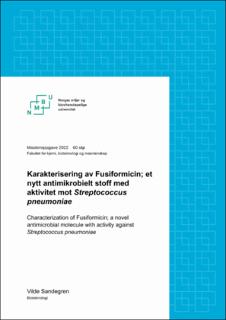| dc.contributor.advisor | Straume, Daniel | |
| dc.contributor.advisor | Kjos, Morten | |
| dc.contributor.author | Sandegren, Vilde | |
| dc.date.accessioned | 2022-09-27T10:46:05Z | |
| dc.date.available | 2022-09-27T10:46:05Z | |
| dc.date.issued | 2022 | |
| dc.identifier.uri | https://hdl.handle.net/11250/3021720 | |
| dc.description.abstract | Antibiotikaresistens regnes som et av de største problemene som verden står ovenfor i dag i forhold til global helse, matsikkerhet og utvikling. Det arbeides med å finne nye antibiotika med aktivitet mot bakterier som bidrar til resistensproblemet. Dette inkluderer Streptococcus pneumoniae, en viktig humanpatogen bakterie med iboende evne til å tilegne seg gener for resistens. I 2020 ble det antimikrobielle stoffet Fusiformicin oppdaget. Fusiformicin produseres av Lysinibacillus fusiformis og har smalspektret aktivitet hovedsakelig mot streptokokker. Stoffets aktivitet har vist direkte sammenheng med peptidtransportsystemet Ami. I denne oppgaven ble det gjort arbeid for å karakterisere stoffet og finne innledende svar på stoffets virkningsmekanisme på S. pneumoniae.
Med proteinase K-behandling og S. pneumoniae-overlay, ble det funnet at Fusiformicin er et peptid, trolig et klasse I- eller II-bakteriosin. Ved å bekrefte uttrykk av AmiE(D184A) og AmiF(D190A) (punktmutasjon i Walker B-motivet) i S. pneumoniae med et immunoblott, ble det basert på tidligere resultater vist at Fusiformicin trenger aktiv form av AmiCDEF for å fungere. Med mutasjon av aminosyrer (S503 og W504) viktige for peptidbinding i AmiA ble det vist at AmiA ikke er nødvendig for Fusiformicins virkning på S. pneumoniae. Likevel viste ektopisk uttrykk av villtype AmiA at proteinet kan bistå i økning av Fusiformicins aktivitet. Motsigende resultater i forhold til Fusiformicins virkningsmekanisme viser til et behov for flere tester for å få svar på om stoffet virker ekstra- eller intracellulært. Dog, dersom virkningsmekanismen er intracellulær ble det tydelig at den ikke er lik virkningsmekanismen til ampicillin eller ciprofloksasin, siden celler behandlet med disse antibiotikumene hadde signifikante endringer i morfologi sammenliknet med Fusiformicin-behandlede celler. Predikasjon av AmiA 3D-struktur viste at proteinet har en peptidbindende kløft med konserverte aminosyrer viktig for peptidbinding lik det homologe proteinet OppA fra L. lactis. Til slutt ble det funnet at AmiACDEF virket toksisk på E. coli, som gjorde at det ikke var mulig å introdusere Ami i andre Gram-positive bakterier slik det var tenkt. Videre arbeid bør inkludere rensing av Fusiformicin til >95% renhet slik at aminosyresekvensen til peptidet (og tilhørende gensekvens) kan avdekkes. | en_US |
| dc.description.abstract | Antibiotic resistance is considered one of the biggest problems that the world faces today related to global health, food security and development. Efforts are being made to find new antibiotics with activity against bacteria that contribute to the resistance problem. This includes Streptococcus pneumoniae, an important human pathogenic bacterium with an inherent ability to acquire resistance genes. In 2020, the antimicrobial compound Fusiformicin was discovered. Fusiformicin is produced by Lysinibacillus fusiformis and has narrow-spectrum activity mainly against streptococci. The activity of the substance has shown a direct connection with the peptide transport system Ami. In this thesis, work was done to characterize the substance and find an initial answer to the substance's mechanism of action on S. pneumoniae.
With proteinase K treatment and an S. pneumoniae overlay, it was found that Fusiformicin is a peptide, probably a class I or II bacteriocin. By confirming expression of AmiE(D184A) and AmiF(D190A) (point mutation in the Walker B motif) in S. pneumoniae with an immunoblot, it was shown based on previous results that Fusiformicin requires the active form of AmiCDEF to have antimicrobial activity. With mutation of amino acids (S503 and W504) important for peptide binding in AmiA, it was shown that AmiA is not necessary for the action of Fusiformicin on S. pneumoniae. Nevertheless, ectopic expression of wild-type AmiA showed that the protein may assist in increasing the activity of Fusiformicin. Due to contradictory results in relation to the mechanism of action of Fusiformicin, several tests must be performed to obtain an answer as to whether the substance acts extra- or intracellularly. However, if the mechanism of action is intracellular, it became clear that it is not similar to the mechanism of action of ampicillin or ciprofloxacin, since cells treated with these antibiotics showed significant different morphological changes compared with Fusiformicin treated cells. Prediction of AmiA 3D structure showed that the protein has a peptide binding cleft with conserved amino acids important for peptide binding similar to the homologous protein OppA from L. lactis. Finally, AmiACDEF was found to be toxic to E. coli, making it difficult to introduce Ami into other Gram-positive bacteria as intended. Further work should include purification of Fusiformicin to >95% purity so that the amino acid sequence of the peptide (and associated gene sequence) can be detected. | en_US |
| dc.language.iso | nob | en_US |
| dc.publisher | Norwegian University of Life Sciences, Ås | en_US |
| dc.rights | Attribution-NonCommercial-NoDerivatives 4.0 Internasjonal | * |
| dc.rights.uri | http://creativecommons.org/licenses/by-nc-nd/4.0/deed.no | * |
| dc.subject | Antibiotikaresistens | en_US |
| dc.title | Karakterisering av Fusiformicin : et nytt antimikrobielt stoff med aktivitet mot Streptococcus pneumoniae | en_US |
| dc.title.alternative | Characterization of Fusiformicin : a novel antimicrobial molecule with activity against Streptococcus pneumoniae | en_US |
| dc.type | Master thesis | en_US |
| dc.description.localcode | M-BIOTEK | en_US |

